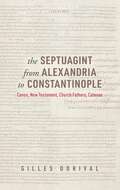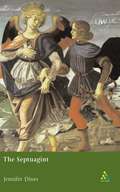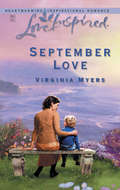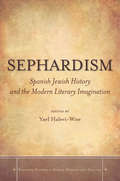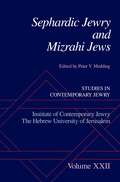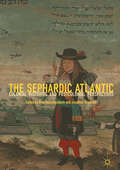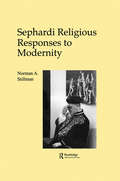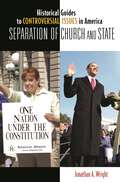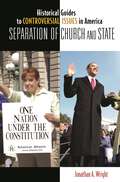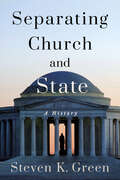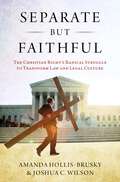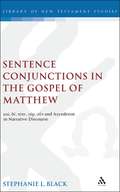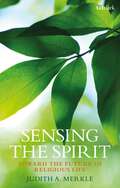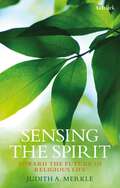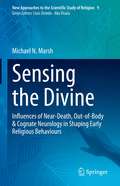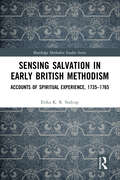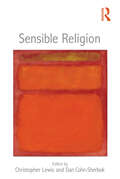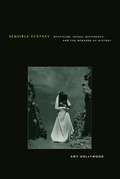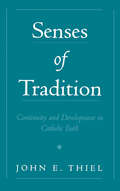- Table View
- List View
The Septuagint from Alexandria to Constantinople: Canon, New Testament, Church Fathers, Catenae
by Gilles DorivalThe Hebrew Torah was translated into Greek in Alexandria by Jewish scholars in the third century BCE, and other 'biblical' books followed to form the so-called Septuagint. Since the Septuagint contains a number of books and passages that are not part of the Hebrew Bible, the study of the Septuagint is essential to any account of the canon of the Hebrew Bible/Old Testament. However, the situation is complex because the Greek text of the Old Testament quoted in the New Testament and in the Church Fathers does not always match the Septuagint text as given by the earliest codices. Furthermore, it must be asked to what extent these texts of the Septuagint may have been Christianized. Up until the fifth century, the Old Testament of the Church Fathers was exclusively the Septuagint—except in the Syriac area—either in its Greek form or in a language translated from this Greek form. The Septuagint thus formed a much more important role in the building of Christian identity than it is usually recognised. After Jerome's Vulgate prevailed in the West, the Septuagint remained the reference text of the catenae. These Byzantine compilations of extracts of Patristic biblical commentary were produced first in Palestine, then in Constantinople and its dependancies between the sixth and fifteenth centuries and became the most important media for the transmission of patristic commentary in these centuries. The patristic extracts in the catenae provide a remarkable witness to the text of the Greek Old Testament as it was known and used by the Church Fathers.
The Septuagint (Understanding the Bible and Its World)
by Jennifer DinesJennifer Dines provides an introductory survey of current scholarship on the Greek Bible - the Septuagint. She outlines its origins in the third to first centuries BCE, going on to trace its subsequent history to the fifth century CE. The Septuagint's relationship with the standard Hebrew text and its translational characteristics are examined, as is its value as a collection with its own literary and exegetical character. The Septuagint is shown to be an important source for biblical studies (both Old and New Testament), to make a distinctive contribution to the history of biblical interpretation, and to be of considerable interest for understanding the early development of both Judaism and Christianity.
September Love (Mills And Boon Love Inspired Ser.)
by Virginia MyersBliss. That' s what Beth Colby thought of her new life and second throw at love. A widow, at fifty she' d met strong, handsome Doug Colby, and he' d swept her into his arms… and right into the chapel. Now she counted her blessings every day.
Sephardism: Spanish Jewish History and the Modern Literary Imagination (Stanford Studies in Jewish History and Culture #180)
by Yael Halevi-WiseIn this book, Sephardism is defined not as an expression of Sephardic identity but as a politicized literary metaphor. Since the nineteenth century, this metaphor has occurred with extraordinary frequency in works by authors from a variety of ethnicities, religions, and nationalities in Europe, the Americas, North Africa, Israel, and even India. Sephardism asks why Gentile and Jewish writers and cultural figures have chosen to draw upon the medieval Sephardic experience to express their concerns about dissidents and minorities in modern nations? To what extent does their use of Sephardism overlap with other politicized discourses such as orientalism, hispanism, and medievalism, which also emerged from a clash between authoritarian, progressive, and romantic ideologies? This book brings a new approach to Sephardic Studies by situating it at a crossroads between Jewish Studies and Hispanic Studies in ways that enhance our appreciation of how historical fiction and political history have shaped, and were shaped by, historical attitudes toward Jews and their representation.
Sephardic Jewry and Mizrahi Jews: Volume XXII (Studies in Contemporary Jewry #Vol # XXII)
by Peter Y. MeddingVolume XXII of the distinguished annual Studies in Contemporary Jewry explores the major and rapid changes experienced by a population known variously as "Sephardim," "Oriental" Jews and "Mizrahim" over the last fifty years. Although Sephardim are popularly believed to have originated in Spain or Portugal, the majority of Mizrahi Jews today are actually the descendants of Jews from Muslim and Arab countries in the Middle East, North Africa, and Asia. They constitute a growing proportion of Israeli Jewry and continue to revitalize Jewish culture in places as varied as France, Latin America, and the United States. Sephardic Jewry and Mizrahi Jews offers a collection of new scholarship on the issues of self-definition and identity facing Sephardic Jewry. The essays draw on a variety of disciplines--demography, history, political science, sociology, religious and gender studies, anthropology, and literature. Contributors explore the issues surrounding the emergence and increasingly wide usage of "Mizrahi" in place of "Sephardic," as well as the invigoration of Sephardic Judaism. They look at the evolution of Sephardic politics in Israel through the dramatic rise and continuing influence of the Shas political party and its spiritual leader, Rabbi Ovadia Yosef. Other contributors examine the variegated nature of Mizrahi immigration to Israel, fictional portraits of female Mizrahi immigrants to Israel in the 1940s and 1950s, contemporary Mizrahi Israel feminism, modern Arab historiography's portrayal of Jews of Muslim lands, and the changing Sephardic halakhic tradition.
The Sephardic Atlantic: Colonial Histories and Postcolonial Perspectives
by Sina Rauschenbach Jonathan SchorschThis volume contributes to the growing field of Early Modern Jewish Atlantic History, while stimulating new discussions at the interface between Jewish Studies and Postcolonial Studies. It is a collection of substantive, sophisticated and variegated essays, combining case studies with theoretical reflections, organized into three sections: race and blood, metropoles and colonies, and history and memory. Twelve chapters treat converso slave traders, race and early Afro-Portuguese relations in West Africa, Sephardim and people of color in nineteenth-century Curaçao, Portuguese converso/Sephardic imperialist behavior, Caspar Barlaeus’ attitude toward Jews in the Sephardic Atlantic, Jewish-Creole historiography in eighteenth-century Suriname, Savannah’s eighteenth-century Sephardic community in an Altantic setting, Freemasonry and Sephardim in the British Empire, the figure of Columbus in popular literature about the Caribbean, key works of Caribbean postcolonial literature on Sephardim, the holocaust, slavery and race, Canadian Jewish identity in the reception history of Esther Brandeau/Jacques La Fargue and Moroccan-Jewish memories of a sixteenth-century Portuguese military defeat.
Sephardi Religious Responses/M
by StillmanFirst Published in 1995. Routledge is an imprint of Taylor & Francis, an informa company.
Sephardi Religious Responses/M
by StillmanFirst Published in 1995. Routledge is an imprint of Taylor & Francis, an informa company.
Separation of Church and State (Historical Guides to Controversial Issues in America)
by Jonathan A. WrightThis tour of the American church/state issue revisits past controversies and personalities in the hope of enlightening present-day debates.Examining an issue that has been a matter of controversy since the founding of the United States, Separation of Church and State offers a chronological survey that helps put the ongoing debate in broad historical context. The book briefly traces the earliest instances of tension between church and state within the Western tradition, from the era of Constantine to the Reformation, before moving on to the American experience. Attention is paid to the colonial debates about the ideal relationship between faith and politics, the 18th-century trends that culminated in a constitutional settlement, and the experiences of various religious groups during the early republic and 19th century. Finally, the book focuses on the post-1940 era, during which church-state controversies came before the Supreme Court. In the course of the discussion, readers will learn about complex legal and theological issues and debates between the great and powerful, but also about ordinary Americans whose religious scruples led to some of the most important legal cases in U.S. history.
Separation of Church and State (Historical Guides to Controversial Issues in America)
by Jonathan A. WrightThis tour of the American church/state issue revisits past controversies and personalities in the hope of enlightening present-day debates.Examining an issue that has been a matter of controversy since the founding of the United States, Separation of Church and State offers a chronological survey that helps put the ongoing debate in broad historical context. The book briefly traces the earliest instances of tension between church and state within the Western tradition, from the era of Constantine to the Reformation, before moving on to the American experience. Attention is paid to the colonial debates about the ideal relationship between faith and politics, the 18th-century trends that culminated in a constitutional settlement, and the experiences of various religious groups during the early republic and 19th century. Finally, the book focuses on the post-1940 era, during which church-state controversies came before the Supreme Court. In the course of the discussion, readers will learn about complex legal and theological issues and debates between the great and powerful, but also about ordinary Americans whose religious scruples led to some of the most important legal cases in U.S. history.
Separating Church and State: A History (Religion and American Public Life)
by Steven K. GreenSteven K. Green, renowned for his scholarship on the separation of church and state, charts the career of the concept and helps us understand how it has fallen into disfavor with many Americans. In 1802, President Thomas Jefferson distilled a leading idea in the early American republic and wrote of a wall of separation between church and state. That metaphor has come down from Jefferson to twenty-first-century Americans through a long history of jurisprudence, political contestation, and cultural influence. This book traces the development of the concept of separation of church and state and the Supreme Court's application of it in the law. Green finds that conservative criticisms of a separation of church and state overlook the strong historical and jurisprudential pedigree of the idea. Yet, arguing with liberal advocates of the doctrine, he notes that the idea remains fundamentally vague and thus open to loose interpretation in the courts. As such, the history of a wall of separation is more a variable index of American attitudes toward the forces of religion and state. Indeed, Green argues that the Supreme Court's use of the wall metaphor has never been essential to its rulings. The contemporary battle over the idea of a wall of separation has thus been a distraction from the real jurisprudential issues animating the contemporary courts.
Separate but Faithful: The Christian Right's Radical Struggle to Transform Law & Legal Culture (Studies in Postwar American Political Development)
by Amanda Hollis-Brusky Joshua C. WilsonFueled by grassroots activism and a growing collection of formal political organizations, the Christian Right became an enormously influential force in American law and politics in the 1980s and 90s. While this vocal and visible political movement has long voiced grave concerns about the Supreme Court and cases such as Roe v. Wade, they weren't able to effectively enter the courtroom in a serious and sustained way until recently. During the pivot from the 20th to the 21st century, a small constellation of high-profile Christian Right leaders began to address this imbalance by investing in an array of institutions aimed at radically transforming American law and legal culture. In Separate But Faithful, Amanda Hollis-Brusky and Joshua C. Wilson provide an in-depth examination of these efforts, including their causes, contours and consequences. Drawing on an impressive amount of original data from a variety of sources, they look at the conditions that gave rise to a set of distinctly "Christian Worldview" law schools and legal institutions. Further, Hollis-Brusky and Wilson analyze their institutional missions and cultural makeup and evaluate their transformative impacts on law and legal culture to date. In doing so, they find that this movement, while struggling to influence the legal and political mainstream, has succeeded in establishing a Christian conservative beacon of resistance; a separate but faithful space from which to incrementally challenge the dominant legal culture. Both a compelling narrative of the rise of Christian Right lawyers and a trenchant analysis of how institutional networks fuel the growth of social movements, Separate But Faithful challenges the dominant perspectives of the politics of law in contemporary America.
Separate but Faithful: The Christian Right's Radical Struggle to Transform Law & Legal Culture (Studies in Postwar American Political Development)
by Joshua C. Wilson Amanda Hollis-BruskyFueled by grassroots activism and a growing collection of formal political organizations, the Christian Right became an enormously influential force in American law and politics in the 1980s and 90s. While this vocal and visible political movement has long voiced grave concerns about the Supreme Court and cases such as Roe v. Wade, they weren't able to effectively enter the courtroom in a serious and sustained way until recently. During the pivot from the 20th to the 21st century, a small constellation of high-profile Christian Right leaders began to address this imbalance by investing in an array of institutions aimed at radically transforming American law and legal culture. In Separate But Faithful, Amanda Hollis-Brusky and Joshua C. Wilson provide an in-depth examination of these efforts, including their causes, contours and consequences. Drawing on an impressive amount of original data from a variety of sources, they look at the conditions that gave rise to a set of distinctly "Christian Worldview" law schools and legal institutions. Further, Hollis-Brusky and Wilson analyze their institutional missions and cultural makeup and evaluate their transformative impacts on law and legal culture to date. In doing so, they find that this movement, while struggling to influence the legal and political mainstream, has succeeded in establishing a Christian conservative beacon of resistance; a separate but faithful space from which to incrementally challenge the dominant legal culture. Both a compelling narrative of the rise of Christian Right lawyers and a trenchant analysis of how institutional networks fuel the growth of social movements, Separate But Faithful challenges the dominant perspectives of the politics of law in contemporary America.
Sentence Conjunctions in the Gospel of Matthew: kai, de, tote, gar, oun and Asyndeton in Narrative Discourse (The Library of New Testament Studies #216)
by Stephanie BlackAn application of current linguistic research on discourse markers to sentence conjunctions in Matthew's Gospel. This treatment combines linguistic insights with a detailed examination of Matthew's use of kai, de and similar conjunctions in narrative passages, culminating in a verse by verse commentary on the structure of Matthew's ;miracle chapters', Matthew 8-9. Black breaks new ground in linguistic theory by modelling the interplay between features such as sentence conjunction, word order, and verb tense in the portrayal of continuity and discontinuity in Greek narrative. A volume of interest to New Testament scholars, classicists, discourse analysts and linguists alike.
Sensing the Spirit: Toward the Future of Religious Life
by Judith A. SNDdeNDrawing on the work of Canadian philosopher Charles Taylor, this book examines how secular culture affects both the living of Christian discipleship today and impacts how religious congregations engage in their own renewal and future. It argues that religious communities can do more than improve and fix the out of date conditions they met in the renewal after Vatican II. Calling on environmental, sociological and theological insights, this book asks how the ongoing “coming of the Kingdom” in the Spirit brings new gifts for these times and how congregations might respond beyond restorative or post-Christian solutions to new challenges confronting them. This book offers a renewed meaning of religious life in secular life and the gift it offers and receives from every culture in which it is embedded.
Sensing the Spirit: Toward the Future of Religious Life
by Judith A. SNDdeNDrawing on the work of Canadian philosopher Charles Taylor, this book examines how secular culture affects both the living of Christian discipleship today and impacts how religious congregations engage in their own renewal and future. It argues that religious communities can do more than improve and fix the out of date conditions they met in the renewal after Vatican II. Calling on environmental, sociological and theological insights, this book asks how the ongoing “coming of the Kingdom” in the Spirit brings new gifts for these times and how congregations might respond beyond restorative or post-Christian solutions to new challenges confronting them. This book offers a renewed meaning of religious life in secular life and the gift it offers and receives from every culture in which it is embedded.
Sensing the Divine: Influences of Near-Death, Out-of-Body & Cognate Neurology in Shaping Early Religious Behaviours (New Approaches to the Scientific Study of Religion #9)
by Michael N. MarshThis book proposes another unique basis for the origins of religion from disturbances in brain function. It proposes the novel idea that near-death and out-of-body experiences (ND/OBE) engendered “a sense of the divine” in ancient man.As the author points out, key aspects of ND/OBE are thematic of all later established religions. These include journeys to heaven, sightings of brightly-lit godlike figures, and dead people now alive. Thus, ND/OBE could be the originating source of these spiritual motifs. To this, the author adds a fourth factor: various brain influences contribute to or modulate ND/OBE. Such cognate neurological disorders include REM-sleep intrusions, sleep paralysis, narcolepsy, and the Guillain-Barré syndrome. Errors due to aberrant switching between key neural control centers disrupt critical state-boundaries between consciousness and dreaming. This may induce NDE. Thus, in this state, subjects temporarily fail to understand where they are, undergo loss of self, and detached from the world. They imagine a “union with Gods.” Here, then, is the biological basis of ineffability.Ancient humans gained beliefs about the "supernatural" through day-to-day existence. This book argues that near death experiences and cognate neurological conditions, some genetically-determined, could have facilitated, even augmented such beliefs. Hence, in configuring another realm of “spiritual” experience beyond the known environment, these neurological possibilities offer effective traction.
Sensing Salvation in Early British Methodism: Accounts of Spiritual Experience, 1735-1765 (Routledge Methodist Studies Series)
by Erika K.R. StalcupThis book examines the spiritual experiences of the first British Methodist lay people and the language used to describe those experiences. It reflects on physical manifestations such as shouting, weeping, groaning, visions, and out-of-body experiences and their role in the process of spiritual development. These experiences offer an intimate perspective on the surprisingly holistic origins of the evangelical revival. The study features autobiographical narratives and other first-hand manuscripts in which “ordinary” lay people recount their first impressions of Methodism, their conflicted feelings throughout the conversion process, their approach toward death and dying, and their mixed attitudes toward the task of writing itself. The book will be relevant to scholars of Methodism, evangelicalism and religious history as well as those interested in emotions and religious experience.
Sensing Salvation in Early British Methodism: Accounts of Spiritual Experience, 1735-1765 (Routledge Methodist Studies Series)
by Erika K.R. StalcupThis book examines the spiritual experiences of the first British Methodist lay people and the language used to describe those experiences. It reflects on physical manifestations such as shouting, weeping, groaning, visions, and out-of-body experiences and their role in the process of spiritual development. These experiences offer an intimate perspective on the surprisingly holistic origins of the evangelical revival. The study features autobiographical narratives and other first-hand manuscripts in which “ordinary” lay people recount their first impressions of Methodism, their conflicted feelings throughout the conversion process, their approach toward death and dying, and their mixed attitudes toward the task of writing itself. The book will be relevant to scholars of Methodism, evangelicalism and religious history as well as those interested in emotions and religious experience.
Sensible Religion
by Christopher Lewis Dan Cohn-SherbokAround the globe religion is under attack. Humanists, secularists and atheists depict believers as deluded and dangerous. The aim of this book is to challenge this perception. Sensible Religion defends the validity and emphasises the excitement of the religious quest across the faiths. It demonstrates that the practice of sensible religion is often a courageous path pitted against religious extremism and secularism. Written by committed believers from the major world's faiths, the book endorses the term 'sensible' as expressing religious reasonableness as well as sensitivity to criticism and new insights. Followers of the different traditions live ordinary lives in the mainstream of the world. This volume therefore addresses beliefs and the manner in which these convictions relate to social, political and ethical action. Countering the argument that religion is at root extremist and irrational, Sensible Religion brings together thoughtful and critical reflections by leading thinkers about humanity's spiritual quest.
Sensible Religion
by Christopher Lewis Dan Cohn-SherbokAround the globe religion is under attack. Humanists, secularists and atheists depict believers as deluded and dangerous. The aim of this book is to challenge this perception. Sensible Religion defends the validity and emphasises the excitement of the religious quest across the faiths. It demonstrates that the practice of sensible religion is often a courageous path pitted against religious extremism and secularism. Written by committed believers from the major world's faiths, the book endorses the term 'sensible' as expressing religious reasonableness as well as sensitivity to criticism and new insights. Followers of the different traditions live ordinary lives in the mainstream of the world. This volume therefore addresses beliefs and the manner in which these convictions relate to social, political and ethical action. Countering the argument that religion is at root extremist and irrational, Sensible Religion brings together thoughtful and critical reflections by leading thinkers about humanity's spiritual quest.
Sensible Ecstasy: Mysticism, Sexual Difference, and the Demands of History (Religion and Postmodernism)
by Amy HollywoodSensible Ecstasy investigates the attraction to excessive forms of mysticism among twentieth-century French intellectuals and demonstrates the work that the figure of the mystic does for these thinkers. With special attention to Georges Bataille, Simone de Beauvoir, Jacques Lacan, and Luce Irigaray, Amy Hollywood asks why resolutely secular, even anti-Christian intellectuals are drawn to affective, bodily, and widely denigrated forms of mysticism. What is particular to these thinkers, Hollywood reveals, is their attention to forms of mysticism associated with women. They regard mystics such as Angela of Foligno, Hadewijch, and Teresa of Avila not as emotionally excessive or escapist, but as unique in their ability to think outside of the restrictive oppositions that continue to afflict our understanding of subjectivity, the body, and sexual difference. Mystics such as these, like their twentieth-century descendants, bridge the gaps between action and contemplation, emotion and reason, and body and soul, offering new ways of thinking about language and the limits of representation.
Sensible Ecstasy: Mysticism, Sexual Difference, and the Demands of History (Religion and Postmodernism)
by Amy HollywoodSensible Ecstasy investigates the attraction to excessive forms of mysticism among twentieth-century French intellectuals and demonstrates the work that the figure of the mystic does for these thinkers. With special attention to Georges Bataille, Simone de Beauvoir, Jacques Lacan, and Luce Irigaray, Amy Hollywood asks why resolutely secular, even anti-Christian intellectuals are drawn to affective, bodily, and widely denigrated forms of mysticism. What is particular to these thinkers, Hollywood reveals, is their attention to forms of mysticism associated with women. They regard mystics such as Angela of Foligno, Hadewijch, and Teresa of Avila not as emotionally excessive or escapist, but as unique in their ability to think outside of the restrictive oppositions that continue to afflict our understanding of subjectivity, the body, and sexual difference. Mystics such as these, like their twentieth-century descendants, bridge the gaps between action and contemplation, emotion and reason, and body and soul, offering new ways of thinking about language and the limits of representation.
Sensible Ecstasy: Mysticism, Sexual Difference, and the Demands of History (Religion and Postmodernism)
by Amy HollywoodSensible Ecstasy investigates the attraction to excessive forms of mysticism among twentieth-century French intellectuals and demonstrates the work that the figure of the mystic does for these thinkers. With special attention to Georges Bataille, Simone de Beauvoir, Jacques Lacan, and Luce Irigaray, Amy Hollywood asks why resolutely secular, even anti-Christian intellectuals are drawn to affective, bodily, and widely denigrated forms of mysticism. What is particular to these thinkers, Hollywood reveals, is their attention to forms of mysticism associated with women. They regard mystics such as Angela of Foligno, Hadewijch, and Teresa of Avila not as emotionally excessive or escapist, but as unique in their ability to think outside of the restrictive oppositions that continue to afflict our understanding of subjectivity, the body, and sexual difference. Mystics such as these, like their twentieth-century descendants, bridge the gaps between action and contemplation, emotion and reason, and body and soul, offering new ways of thinking about language and the limits of representation.
Senses Of Tradition: Continuity And Development In Catholic Faith
by John E. ThielThis book articulates a theory of Catholic tradition that departs from previous understandings. Drawing on the medieval concept of the four-fold sense of scripture, John Thiel proposes four interpretive senses of tradition. He also offers a theory of doctrinal development that reconciles Catholic belief in apostolic authority and continuity of tradition with a critical approach to the evidence of history.
